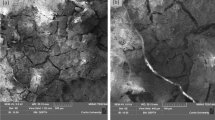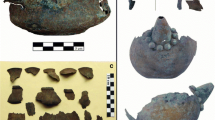Abstract
Iron corrosion is a complex process that occurs in buried artefacts. In this work, we studied thirteen iron artefacts excavated from the Yueyang City site in Xi’an, China, which was a capital city during the Qin and Han dynasties approximately 2000 years ago. Metallography, SEM–EDS, and micro-Raman spectroscopy were used for artefact examination, and the results indicated that these iron artefacts were made from indirect processes of white cast iron, mottled cast iron, cast iron with solid-state decarburization, and liquid-state decarburization. Preferential corrosion was closely related to the metallographic phase. Lamellar pearlite was more easily corroded than ferrite, while ferrite was more preferentially corroded than spheroidal pearlite. Slag inclusions readily initiated the corrosion of the surrounding metal substrate. The main corrosion products were goethite, magnetite, hematite, lepidocrocite, and akaganeite. The results of this work provide a deeper understanding of the corrosion mechanism of iron artefacts and can be used to evaluate the necessity of de-chloride conservation.












Similar content being viewed by others
Data Availability Statement
The authors confirm that the data supporting the findings of this study are included within this published article.
References
D.B. Wagner, Iron and steel in ancient China (E. J. Brill, New York, 1996), pp.247–334
D.B. Wagner, Chemistry and chemical technology part 11: ferrous metallurgy. Joseph Needham. Science and civilisation in China (Cambridge University Press, Cambridge, 2008), pp.115–248
Rubin H., Jun K. (2007) History of science and technology in China. Vol. Mining. Science Press, Beijing 446 (in Chinese)
B. Yunxiang, Archaeological research on iron artefacts dating from pre-Qin and Han dynasties (Science Press, Beijing, 2005)
S. Ji, Materials cultural in ancient China (Zhonghua Book Company, Beijing, 2014), pp.213–367. ((in Chinese))
L. Wengcheong, Everything old is new again? Rethinking the transition to the cast iron production in the Central Plains of China. J. Anthroplo. Res. 70, 511–542 (2014)
W. Lam, J. Chen, J. Chong et al., An iron production and exchange system at the center of the Western Han Empire: Scientific study of iron products and manufacturing remains from the Taicheng site complex. J. Archaeol. Sci. 100, 88–101 (2018)
Y. Liu, M.M.M. Chen et al., Iron decarburization techniques in the eastern Guanzhong Plain, China, during Late Warring States period: an investigation based on slag inclusion analyses. Archaeol. Anthropol. Sci. (2019). https://doi.org/10.1007/s12520-019-00921-5
Q. Zhao et al., Re-discussion about the iron foundry site in Tieshenggou, Gong county. Acta Archaeologica Sinica 2, 157–183 (1985). ((in Chinese))
F. Zhao, M. Sun, X. Li et al., The manufacturing technology of iron swords from the capital of the Han Empire in China. SN Appl Sci 2, 1510 (2020). https://doi.org/10.1007/s42452-020-03312-x
D. Fuyun, H. Rubin, Scientific analysis on some iron artefacts unearthed from arsenal site of Han Changan city site// A CASS. Arsenal of Han Changan city site (Cultural Relic Press, Beijing, 2005), pp.132–133
Xi’an Institute of Cultural Heritage Conservation and Archaeology, Excavation of the ancient bridges over the Jue river of the Han Chang’an city. ACTA Archaeol. Sinica 3, 369–400 (2012)
J. Shi, F. Zhao, X. Li, Research on large cast iron artefacts discovered from the ancient bridge site in Xi’an. Relics Museolgy 6, 106–112 (2019)
S. Réguer, P. Dillmann, F. Mirambet, Buried iron archaeological artefacts: corrosion mechanisms related to the presence of Cl-containing phases. Corros. Sci. 49, 2726–2744 (2007)
D.E. Watkinson, M.B. Rimmer, N.J. Emmerson, The influence of relative humidity and intrinsic chloride on post-excavation corrosion rates of archaeological wrought iron. Stud. Conserv. (2019). https://doi.org/10.1080/00393630.2018.1565006
E. Nordgren, The effect of metallurgical structure on the chloride-induced corrosion of archaeological wrought iron (Cardiff University in candidature, UK, 2016)
R.P.M. Procter, Outline of structural metallurgy relevant to corrosion. Shreir’s Corrosion 20, 94–130 (1994)
Y. Rong, Microscopic analysis of corrosion of iron relics unearthed from Shenmingpu site. J. Xianyang Normal Univ. 27(4), 87–90 (2012). ((in Chinese))
Z. Wang, C. Xu, M. Yang, Difference of local corrosion behaviors of archaeological cast irons with four different microstructures in soil. Foundry Technology 28(7), 968–973 (2007). ((in Chinese))
D.A. Jones, Principles and Prevention of Corrosion (Pearson, Harlow, 2014), p.324
K. Kreislova, D. Knotkova, H. Geiplova, Atmospheric corrosion of historical industrial structures, in Corrosion and conservation of cultural heritage metallic artefacts. ed. by P. Dillmann et al. (Woodhead, Cambridge, 2013), pp.311–342
D. Neff, S. Reguer, L. Bellot-Gurlet et al., Structural characterization of corrosion products on archaeological iron: an integrated analytical approach to establish corrosion forms. J. Raman Spectrosc. 35, 739–745 (2004)
J. Monnier, D. Neff, S. Reguer et al., A corrosion study of the ferrous medieval reinforcement of the Amiens cathedral Phase characterisation and localization by various microprobes techniques. Corrosion Science 52(3), 695–710 (2010)
Institute of Archaeology–CASS, Xi’an Institute of conservation and archaeology, 2016 The excavation of Qin-Han Yueyangcheng site at Yanliang district, Xi’an city. Archaeology 9: 54–69 (in Chinese)
P. Dillmann, M. L’Héritier, Slag inclusion analyses for studying ferrous alloys employed in French medieval buildings: supply of materials and diffusion of smelting processes. J. Archaeol. Sci. 34(11), 1810–1823 (2007)
J. Chen, Z. Zhang, Identification of ancient Chaogang technology based on slag. Cult Relics Southern China 1, 115–121 (2016). ((in Chinese))
Y. Liu, K. Chen, J. Mei et al., Scientific analysis on iron artefacts unearthed from burials of the Qin State at Xinfeng Town in Lintong, Shannxi. Archaeology 7, 108–116 (2019). ((in Chinese))
P.T. Craddock, Early metal mining and production (Edinburgh University Press, Edinburgh, 1995)
P. King, The production and consumption of bar iron in early modern England and Wales. Econ Hist Rev 58(1), 1–33 (2005)
Rostoker W., Bronson B. (1990). Pre-industrial iron: its technology and ethnology. Archeomaterials Monograph No. 1, Philadelphia
Y. Liu, M.M.M. Mei et al., Cast a different iron: grey and mottled cast iron production in early China. J. Cult. Herit. (2020). https://doi.org/10.1016/j.culher.2020.05.005
Y. Huang, B. Lin, C. Wang et al., The structural characteristics of corrosion products on the ancient ironware. Sci. Conserv. Archaeol. 8(1), 24–28 (1996). ((in Chinese))
H. Yuan, Z. Zhang, Q. Ma, Analysis of iron cannon at Hulishan battery. Chin J Rare Metals 34, 101–106 (2010). ((in Chinese))
J. Li, T. Fan, Field conservation of large iron pot in the Sizhou city site of Xuyi in Jiangsu Province. Sci Conserv Archaeol 29(3), 73–78 (2017). ((in Chinese))
S. Grousset, M. Bayle, A. Dauzeres et al., Study of iron sulphides in long-term iron corrosion processes: characterisations of archaeological artefacts. Corros. Sci. (2016). https://doi.org/10.1016/j.corsci.2016.07.022
G. Pingitore, T. Cerchiara, G. Chidichimo et al., Structural characterization of corrosion product layers on archaeological iron artifacts from Vigna Nuova, Crotone (Italy). J. Cult. Herit. (2015). https://doi.org/10.1016/j.culher.2014.07.003
L.S. Selwyn, P.J. Sirois, V. Argyropoulos, The corrosion of excavated archaeological iron with details on weeping and akaganeite. Stud. Conserv. 44(4), 217–232 (1999)
Acknowledgements
The authors greatly appreciate the funding obtained from the Xi’an Institute of Conservation and Archaeology (20SFSF0010). We also thank Rui Liu, Xiaojuan Huang, Weiqun Yao, and Yamin Zhang for their help with data collection and experimental analysis.
Author information
Authors and Affiliations
Corresponding author
Rights and permissions
Springer Nature or its licensor (e.g. a society or other partner) holds exclusive rights to this article under a publishing agreement with the author(s) or other rightsholder(s); author self-archiving of the accepted manuscript version of this article is solely governed by the terms of such publishing agreement and applicable law.
About this article
Cite this article
Zhao, F., Fu, W., Bai, L. et al. Metallographic structures and corrosion: cross-section investigation of archaeological iron objects from the Qin-Han Yueyang City site in Xi’an, China. Eur. Phys. J. Plus 138, 64 (2023). https://doi.org/10.1140/epjp/s13360-022-03643-1
Received:
Accepted:
Published:
DOI: https://doi.org/10.1140/epjp/s13360-022-03643-1




